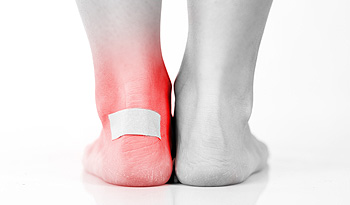Anyone who wears shoes knows how painful a blister on your foot can be. Blisters can occur when your shoe rubs against your skin and irritates it to the point where the neighboring tissues react and leak fluid (serum). This serum collects in a sac under the top layer of skin, which provides natural protection for skin underneath the blister. There are several things you can do to help avoid a blister from forming such as wearing shoes that fit properly and don't cramp your toes or allow your foot to slip around, slowly getting your feet used to new shoes by wearing them for short periods of time at first, covering rough inseams in shoes or socks with pads or tape, wearing double-layered socks that keep moisture away from skin (softened skin tends to blister more easily), and reducing friction on possible hot spots with petroleum jelly or other lubricants. For more tips on proper footwear and how to avoid blisters—or if you have a blister that will not heal—contact a podiatrist for advice and treatment to prevent an infection from developing.
Blisters are prone to making everyday activities extremely uncomfortable. If your feet are hurting, contact Dr. Mark Gagnon of Advanced Podiatry. Our doctor can provide the care you need to keep you pain-free and on your feet.
Foot Blisters
Foot blisters develop as a result of constantly wearing tight or ill-fitting footwear. This happens due to the constant rubbing from the shoe, which can often lead to pain.
What Are Foot Blisters?
A foot blister is a small fluid-filled pocket that forms on the upper-most layer of the skin. Blisters are filled with clear fluid and can lead to blood drainage or pus if the area becomes infected.
How Do Blisters Form?
Blisters on the feet are often the result of constant friction of skin and material, usually by shoe rubbing. Walking in sandals, boots, or shoes that don’t fit properly for long periods of time can result in a blister. Having consistent foot moisture and humidity can easily lead to blister formation.
Prevention & Treatment
It is important to properly care for the affected area in order to prevent infection and ease the pain. Do not lance the blister and use a Band-Aid to provide pain relief. Also, be sure to keep your feet dry and wear proper fitting shoes. If you see blood or pus in a blister, seek assistance from a podiatrist.
If you have any questions, please feel free to contact one of our offices located in Crestwood, Orland Park, and Summit, IL . We offer the newest diagnostic and treatment technologies for all your foot care needs.

